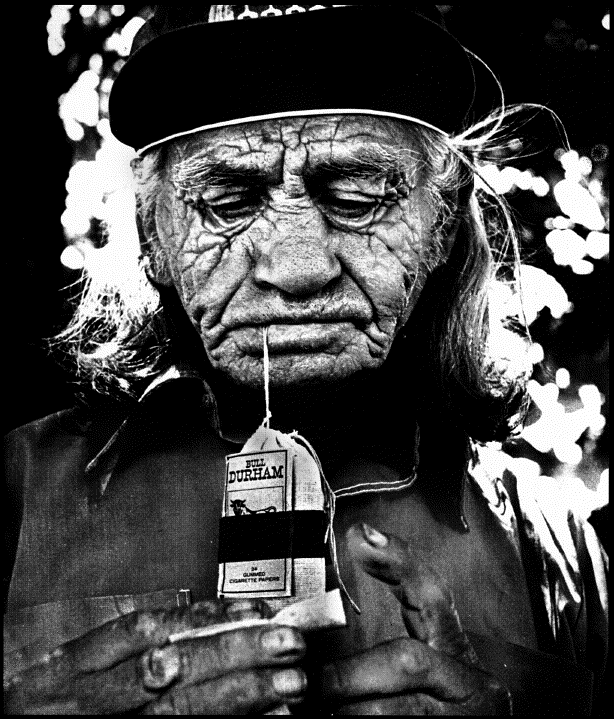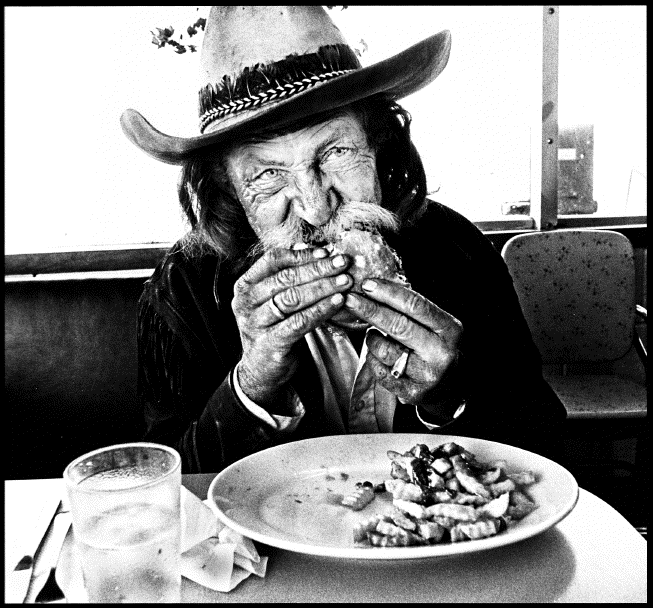
Shooting from the Hip
Photographs and Essays
J. Don Cook
(University of Oklahoma)

J. Don Cook grew up in that part of the middle west that most of us go past as quickly as possible. We're talking about the panhandle part of Oklahoma and Texas. Cook says the landscape is subtle, a more muted color than the rest of the country, but it looks like dust to me, along with rattlesnakes and lizards and people dying to get out of there ... dying of old age and boredom if they don't.Cook includes enough of his personal biography that you and I can praise god that we missed it: a mother who had to be committed from time to time, a stepfather who "broke straps" on his back, family trips in a 1936 Ford west on Highway 66 to California to pick fruit ... and the usual plague of American Indian life: drunkenness, the dying of the reservation, hideous poverty ... the plight of the very poor in prairie country.
Fortunately Cook was a resilient type. He took to books to escape a daily ongoing horror movie of his life. When he was twenty, he got a job working for a newspaper in Ada, Oklahoma. And with his camera, he learned how to record the bitter, sometimes comical, often starkly beautiful people around him.
Shooting from the Hip includes sixty or so black-and-white pictures of the old, the grizzled, the astonishing faces around him. There are, too, the children, along with his brothers and sisters (Cook is part Chickasaw, Cherokee, and Choctaw). He also documents another side of panhandle life: Ku Klux Klan meetings, old people barely surviving, children living innocently in the shadow of their families' desolation.
§ § § There are thirty-three essays that accompany the photographs, some with romantic titles that might make one think this is a sunny life out there, taken from a brochure put out by the Norman OK Chamber of Commerce: "Summertime," "Memorial Day," "An Old-Fashioned Haircut," "Daughters." But, too, there are titles like "Tornado Victim," "Double Drowning," "A Deadly Shootout," "A Ruined Life." Theoretically, Cook is showing us the polar opposites ... but to this viewer, the photographs mostly deliver a sunny view of things. The close-ups of the wrinkled old faces are weathered, startlingly lined, but benign. The children are curious, smiling, almost always clean. The shot of a kid getting a haircut looks like something that Norman Rockwell would have painted ... as are children shown with snowy rabbits, boys with water-hose, youngsters with Sno-cones.
Cook says that one of his mentors is Walker Evans, but Evans was scrupulous about keeping sentiment as far away as possible. For Evans, there was always an edge of pain; but it was the pain of understatement. Cook is rarely understated. When he shows "A Drowning in August," it is of a father carrying the body of his seven-year-old child, the man's face is in a shocked, contorted spasm of grief.
As a good action photographer must, Cook asks himself if he should be photographing such things. He tells us that he even wrote "a first person essay for a national magazine about the experience of having to document the suffering of people I knew --- resisting the urge simply to leave and not photograph."
There I was, the professional part of me documenting this human tragedy while the lives of two families, neighbors, were shredded beyond repair.
And there you have, in its starkest form, the paradox of choosing (or not choosing) to record tragedy. Many of us would turn away, or try merely to help in whatever way we could. Cook takes pictures of what most would consider a private grief and throws them out for the world to have and to hold: photographs set forth in a very public space called, perhaps ironically, Shooting from the Hip.
